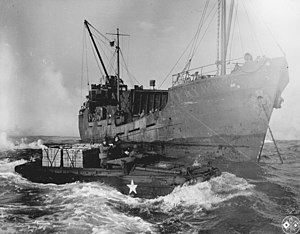
American transportation played a crucial part in the military logistics of the World War II Siegfried Line campaign, which ran from the end of the expulsion of the German armies from Normandy in mid-September 1944 until December 1944, when the American Army was engulfed by the German Ardennes offensive. In August 1944, the Supreme Allied Commander, General Dwight D. Eisenhower, elected to continue the pursuit of the retreating German forces beyond the Seine instead of pausing to build up supplies and establish the lines of communication as called for in the original Operation Overlord plan. The subsequent advance to the German border stretched the American logistical system to its breaking point, and the advance came to a halt in mid-September.
The Germans attempted to delay the Allied advance until the onset of bad weather by denying access to ports and demolishing communications infrastructure in order to give their own forces time to recover. Between September and November, the American forces in Europe suffered from severe transportation problems. In September, Cherbourg was the only deep-water port in northwest Europe in Allied hands capable of handling Liberty ships, but it had been badly damaged, and took a long time to restore. Smaller ports could handle only small, shallow-draft coastal trading vessels known as "coasters". Two-thirds of the British coaster fleet, on which critical industries depended, was dedicated to the campaign. Over time, rough seas, enemy action and continuous use laid up a quarter of the coaster fleet for repairs. From September onwards, an increasing volume of supplies came directly from the United States. These were stowed in Liberty ships so as to make optimal use of their cargo space. The shipments frequently included heavy and bulky items that required dockside cranes to unload. The available port capacity was insufficient to unload the ships arriving. As the number of ships awaiting discharge in European waters climbed, turnaround times increased, and fewer ships reported back to port in the United States, precipitating a widespread shipping crisis.
Additional port capacity was obtained through the opening of Rouen and Le Havre in September and October respectively, and of Antwerp in November. Antwerp was capable of handling all the Allies' needs, but before the war it had been a transit port, and did not possess large amounts of covered storage space. The Americans were allocated only a small amount of this, all uncovered, on the assumption that American supplies would immediately be moved to the depots around Liège. The limiting factor then shifted to port clearance. Initially, motor transport was widely used, but as the railways were brought back into service, they shouldered the burden of moving supplies from the ports to the depots. Inland water transport was developed to relieve pressure on the railways. Four waterways were rehabilitated for military use: the Seine, Oise and Rhône rivers, and the Albert Canal. Air transport was the least economic form of transport, but in September and October, with road and rail transport unable to supply even the minimum daily requirements of the armies, it was called upon to supplement them.
Although logistical difficulties constituted a brake on combat operations, they were not the only factors that brought the Allied advance to a halt. The American forces also had to contend with rugged terrain, worsening weather and, above all, with stubborn German resistance. The German recovery was sufficient to mount the Ardennes offensive in December. This threatened Antwerp and the depot areas around Liège, which also came under attack from German V-weapons and air raids. This placed immense strain on the American communications, but by the new year the American transportation system was more robust than ever, and preparations were under way to support the final assault on Germany.
